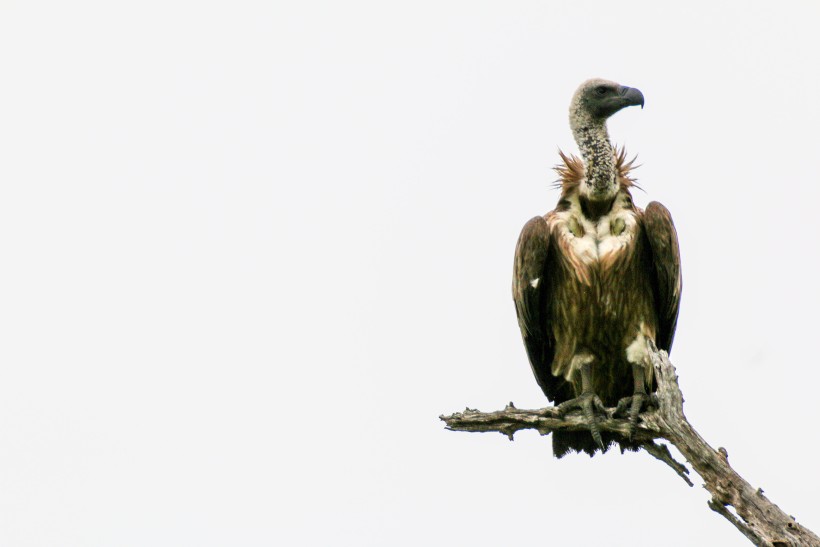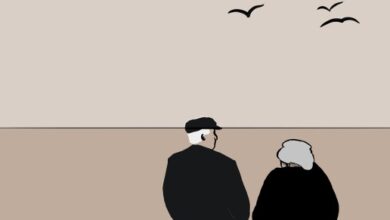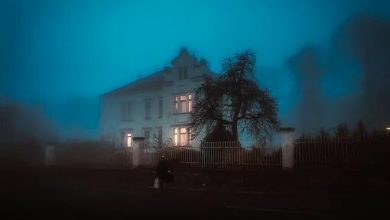
Published by Chinua Achebe in 1971, Vultures is a poem of four uneven stanzas, written in free form. It discusses the elements of love and evil in the world, using a comparison of vultures with the Commandant at Belsen Camp to highlight the link between humans and nature.
Vultures | Summary
The poem starts with a dull, gloomy setting. It is a grey dawn, and the despondence isn’t diffused even by the vultures perched on the branches of a dead tree. There are two of them- presumably mates– nestled close together, and one of them has a pebble on a stem tangled its unkempt feathers. Yesterday, those vultures had found a corpse in a trench, and had picked away its eyes and eaten everything of its bowel. After being full and satisfied, they found a place to rest close by, so that the remnants of the body were still in their line of sight.
After this description, the perspective switches from the vultures to thoughts about the peculiarity of love. It is strange how love, which is otherwise so particular, can still exist in even the eeriest of places- and when it does, it prefers to turn it’s face to the wall rather than to look at the darkness that surrounds it. The third stanza then shifts its focus to the Commandant at Belsen Camp, who at the time is finishing work and going home for the day. He smells like burnt bodies, and stops at the sweet shop on his way home to pick up chocolate for his child, who is eagerly awaiting his return.
The final stanza talks about how there is always light in the darkness, and love in evil. The poet wonders if it should be praised that even an ogre is gifted with a tiny bit of tenderness– a soft glow in its otherwise cold and emotionless heart- or whether it should be despaired that for every small speck of love, we find huge amounts of evil.
Vultures | Analysis
Chinua Achebe is a Nigerian poet and novelist. He is known for crafting his fiction around elements of reality– similar to how, in Vultures, he uses nature and human beings to depict abstract concepts like love, light, darkness, good and evil. This poem uses strong imagery. Achebe also employs extended metaphors and descriptions to portray emotions. His comparisons also assist in painting the scene in the readers’ minds most vividly. Vultures is split into four uneven stanzas, and does not have a specific rhyme scheme. It is written in third-person free form, and the personification of emotions is employed to form a stronger sense of understanding and relatability.
Vultures Poem Analysis, Stanza 1
In the greyness
and drizzle of one despondent
dawn unstirred by harbingers
of sunbreak a vulture
perching high on
bones of a dead tree
nestled close to his
mate his smooth
bashed-in head, a pebble
on a stem rooted in
a dump of gross
feathers, inclined affectionately
to hers. Yesterday they picked
the eyes of a swollen
corpse in a water-logged
trench and ate the
things in its bowel. Full
gorged they chose their roost
keeping the hollowed remnant
in easy range of cold
telescopic eyes…
Achebe begins the poem by creating a despondent atmosphere. The use of vultures in the story is symbolic of death and greed. This is further emphasized by the line “perching high on bones of a dead tree.”- the specification of the tree being dead is to represent the meaning behind the vultures. It is these details that not only set the scene but also help the readers understand the general theme of the poem. The vultures are described with a “smooth bashed-in head, a pebble on a stem rooted in a dump of gross feathers.” and were said to have been eating a corpse’s remains. This creates a dark and rough aura around the birds, making them seem uncaring and heartless. However, in subtle contrast, one vulture is “nestled close to his mate” and “inclined affectionately”. There is a sharp difference between the cold mechanicalistic nature of the vulture’s appearance and their fond actions towards one another- yet, they coexist. This is a small hint to the larger topic of the poem: the presence of light in darkness and love in evil. Here, the vultures- which represent dark, unforgiving things- are the evil, but the love they have for each other is the light within that cave.
Vultures | Poem Analysis, Stanza 2
Strange
indeed how love in other
ways so particular
will pick a corner
in that charnel-house
tidy it and coil up there, perhaps
even fall asleep – her face
turned to the wall!
The vulture is a symbolic element used to set the scene, and now in stanza two, the focus shifts away from the vultures and towards the abstract themes of love. It is interesting to note that Achebe personifies ‘love’ to a certain degree, referring to the emotions as ‘her’ and describing its presence in one’s heart as though it were a person living on the earth- portraying ‘love’ as ‘light’ and ‘death’ as ‘darkness’, a clever comparison is made through imagery. “Strange how love will pick a corner in that charnel-house tidy it and coil up there”- a charnel-house is a building where corpses and skeletons are kept- it symbolizes lifelessness and destruction. Saying that love will ‘coil up there’ is hints at the way love can appear even in the most dreadful times and within the most heartless people. The line “Perhaps even fall asleep – her face turned to the wall!” suggests that though love will remain there, she is so horrified by the atrocities she sees that she prefers to be blind to it. So she remains there, in the dark place, but faces the wall so she does not have to witness anything. The imagery of ‘love’ as a woman persisting even in a place as terrible as a charnel-house, refusing to look at the dead bodies but also refusing to leave, is the perfect depiction of the presence of love in the most awful and unexpected situations.
Vultures Poem Analysis, Stanza 3
…Thus the Commandant at Belsen
Camp going home for
the day with fumes of
human roast clinging
rebelliously to his hairy
nostrils will stop
at the wayside sweet-shop
and pick up a chocolate
for his tender offspring
waiting at home for Daddy’s
return…
The third stanza moves from the description of abstracts to the observation of a human– the Commandant at Belsen Camp. It is very interesting that Achebe chooses to include a description of a man here after two stanzas about nature and emotion– this is what links the concepts of humans and nature together in this poem. He shows how darkness and light exist everywhere– not just nature and animals, but in human beings, too. The Commandant is described rather unfavorably– Achebe possibly uses the Commandant as a human form of the vulture. Both represent death and darkness, and draw the necessary connection between human nature and simply nature.
The Commandant smelled of “fumes of human roast” which tells the readers what he did that day- burnt human beings to death. However, he is picking up sweets for his child. Within the cruelty and ruthlessness of a war criminal, we see a soft side– the affection he holds for his son or daughter. Despite everything he did that day, all the people he harmed and deaths he saw, he returns to a young child with love in his heart. This once again highlights the presence of light even in the darkness. It evokes the thought that everyone has some good inside them, no matter how terrible their nature or profession may be. The contrast between his “human roast” scent, and the use of the words “tender offspring” to describe his child, form a clear picture of the struggling coexistence of two elements in a human being. “Waiting at home for Daddy’s return…” shows that the child is unaware of everything her father does at work- she just wants to see him. This display of childish innocence and naivety is representative of love and light.
Vultures Poem Analysis, Stanza 4
Praise bounteous
providence if you will
that grants even an ogre
a tiny glow-worm
tenderness encapsulated
in icy caverns of a cruel
heart or else despair
for in the very germ
of that kindred love is
lodged the perpetuity
of evil.
So far, through three stanzas, we have seen and felt the existence of love within the darkness- through nature, through abstract personification, and through human interaction. The affection for the mate was the light in the vulture’s darkness, the ‘woman’ named love was the light in the eerie corpse room, and the “tender offspring” was the light in the life of the merciless Commandant. In the final stanza, Achebe concludes the poem with a general reflection. He muses these thoughts and wonders whether to be happy or sad about this small presence of love.
He says “even an ogre a tiny glow-worm tenderness encapsulated in icy caverns of a cruel heart.” Ogres are known in mythology for feeding on human beings– once again, bringing in the theme of death represented by the vulture, the charnel house and the Commandant. Either for feasting on remains of corpses, containing corpses, or creating corpses, each stanza had a representation of death. In the final stanza, it is the ogre, who eats the human alive. The poem discusses that despite being such a terrifying and ruthless creature, it has a miniscule amount of tenderness in its heart. The phrase ‘icy caverns’ underlines how brutal and loveless the ogre’s heart is. This depiction once more signifies the presence of light in darkness.
However, the poet wonders whether this is a thing to be praised or despaired. Is it a positive thing that no matter how much darkness there is, we will still find at least a flicker of light? Or is it a misfortune that we can never find light unless it is surrounded by total darkness? These two perspectives are similar to the yin-and-yang, which depicts dualism– the interconnected yet contradictory forces of the natural world: we cannot find one without the other. Another point to note is the way Achebe finished the poem- most specifically, his placement of the lines about praise and despair. This order-structure is a clever way to resonate with the readers, as the closing line of a poem can set the tone for its final perception. It is interesting that Achebe chose to end the poem after stating the despair rather than the praise- it creates a sustaining feeling of bleakness after the poem comes to a close, as the darkness seems enduring and unending.



